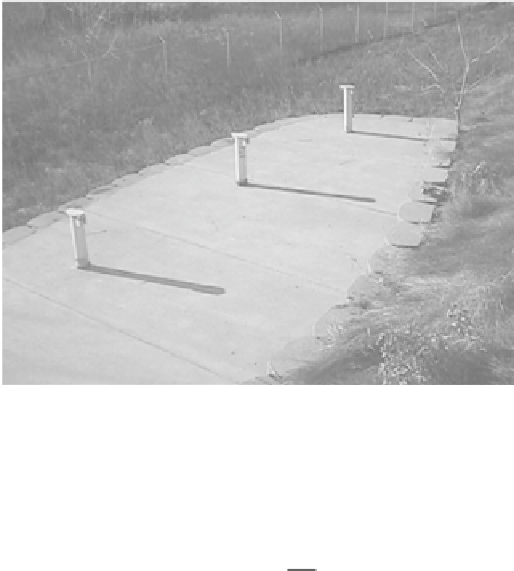Environmental Engineering Reference
In-Depth Information
Specific conductance, pH, dissolved oxygen, and
temperature of groundwater may be measured in
the field. Retrieved water samples are stored,
sealed, and transported to the designated labora-
tory for analysis.
Decontamination and Waste Disposal.
Drilling
augers, auger bits, split-spoon samplers, and other
soiled equipment should be steam cleaned prior
to use, double-rinsed in tap water, and finally,
rinsed with distilled water. All drill cuttings and
liquid wastes, including well development water,
should be containerized for appropriate disposal.
Well Survey.
The location and elevation of the top of
the casing of a monitoring well should be surveyed
and connected to appropriate state or other plane
coordinates and referenced to a vertical datum.
The survey information should be indicated on
site maps and kept with other monitoring well
records.
Figure 5.17.
Cluster of monitoring wells.
size as
d
10
of the gravel pack. If
U
c
is the uniformity
coefficient of the gravel pack,
EXAMPLE 5.18
d
U
60
d
=
10
A monitoring well is to be installed to measure the
water quality in an aquifer. A grain-size analysis of the
aquifer matrix indicates that
d
10
= 0.15 mm,
d
30
= 0.2 mm,
d
60
= 0.6 mm, and
d
90
= 1.6 mm. (a) Determine whether
an artificial gravel pack is necessary. If a gravel pack is
required, write the specifications for the gravel pack.
(b) Assuming that all natural and artificial gravel packs
have the property that
d
60
≈ 1.1
d
50
, determine the
required slot size for the well screen.
c
Taking
d
60
= 1.1
d
50
= 1.1(0.94) = 1.0 mm and
U
c
= 2
yields
1 0
2
.
d
10
=
=
0 50
. mm
Therefore, a 20-slot screen (slot size = 0.50 mm) is
recommended.
Solution
In most site investigations, water samples are required
at several depths at a single location. Under such cir-
cumstances, either a cluster of wells or multilevel sam-
plers within a single well are used. At well clusters, each
well is completed in its own borehole, and a typical well
cluster is shown in Figure 5.17.
(a) An artificial gravel pack is required when less than
90% of the aquifer material is retained by a 10-slot
screen. The size of a 10-slot screen is 0.25 mm. From
the data given, 90% of the aquifer matrix has a grain
size larger than
d
10
= 0.15 mm. Therefore, a 10-slot
screen will retain less than 90% of the aquifer
matrix and an artificial gravel pack is required. The
average grain size of the gravel pack should be two
times the average grain size of the aquifer matrix.
Taking the average grain size of the aquifer matrix
as
d
50
, interpolating from the given data (between
d
30
and
d
60
) yields
d
50
≈ 0.47 mm. Therefore, the
specifications of the gravel pack are (1) average
grain size = 2 × 0.47 mm = 0.94 mm, (2) uniformity
coefficient = 2-3, (3) thickness = 5 to 8 cm, and
(4) the gravel pack should extend 60-90 cm above
the top of the screen.
(b) The well screen is to have a slot size that retains
90% of the gravel pack. Therefore, take the screen
5.8 REMEDIATION OF SUBSURFACE
CONTAMINATION
Subsurface contamination is commonly caused by either
spills of toxic substances or the leakage of toxic chemi-
cals from storage containers (tanks). Contaminants of
concern include nAPLs that leave a trail of contami-
nant at the residual saturation level in the soil, and if a
sufficient amount of contaminant is spilled, the nAPL
reaches the saturated zone, where it either floats on the
water table (LnAPLs) or sinks to the bottom of the
aquifer (DnAPLs). Residual nAPLs within the soil and

Search WWH ::

Custom Search